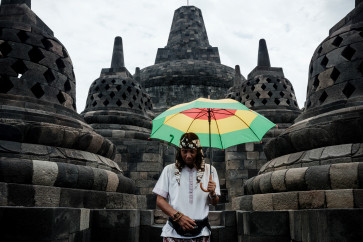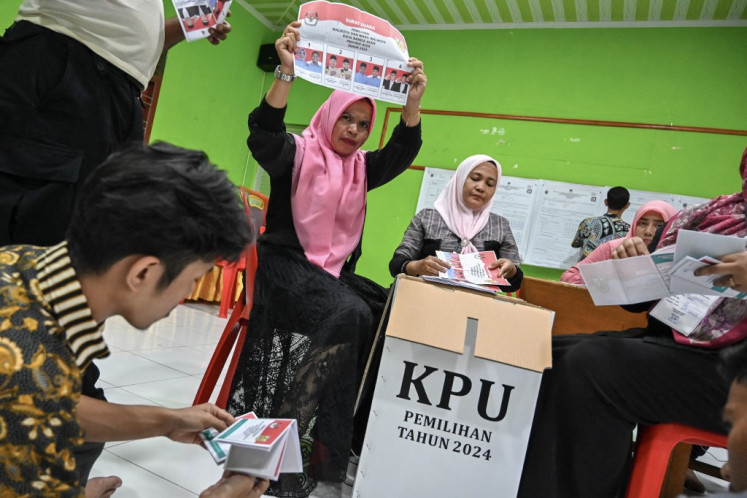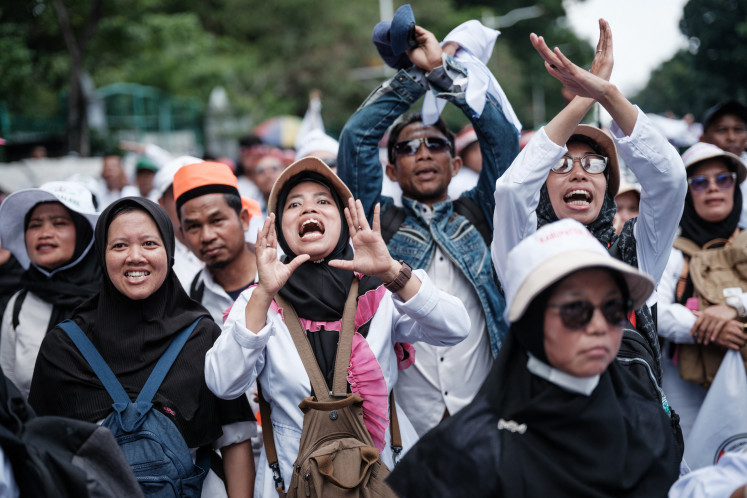Popular Reads
Top Results
Can't find what you're looking for?
View all search resultsPopular Reads
Top Results
Can't find what you're looking for?
View all search resultsCreative Smarts: Batik Knows No Bounds
ON DISPLAY: Tembayat batik from Klaten is known for the use of natural coloring agents
Change text size
Gift Premium Articles
to Anyone
ON DISPLAY: Tembayat batik from Klaten is known for the use of natural coloring agents.
Once exclusive to the courts of Java, particularly Yogyakarta and Surakarta, today batik is considered an inseparable part of the life of modern Indonesian society.
There is increasing national pride for the fabric and its meaning, especially following the recognition of Indonesian batik as a Masterpiece of Oral and Intangible Heritage of Humanity on Oct. 2, 2009.
While the advent of “batik Fridays” encourages people to wear the fabric at least once a week during their daily lives, others want it to be considered befitting everyday attire.
In Malang, East Java, Komunitas Cinta Berkain (KCB) is a group that advocates the wearing of traditional wrap skirts.
“Women should be proud of using local products because the more people enjoy their creations, the more craftspeople will be keenly engaged in their creative work,” said chairwoman Dewanti Rumpoko during the exhibition The Elegance of Batik Djawa, held at Hotel Tugu Malang in mid-April.
Founded at the end of January 2016, the community has at least 250 members, whose task is to popularize the use of kain for women in their daily activities, not only for important occasions.
“With exact practice, it takes just five minutes to finish wrapping and tying the cloth neatly,” said Dewanti, who added it was not necessary to wear expensive batiks despite their prestige value.
Since its founding, KCB has held regular meetings with different women’s organizations, including the Family Welfare Association (PKK) and Dharma Wanita grouping of wives of civil servants. Fashion specialists demonstrate to members the proper way to wear the wrap-skirt and combine it with other clothing elegantly.
The wife of Batu mayor Eddy Rumpoko said the women’s organizations should set an example for the public at large, or else the fabric could lose its popularity or even be claimed by other nations as belonging to them.
SIGNATURE STYLE: Batik from Tulungagung in East Java mostly features flowers as its motif.
Diverse Meanings
The exhibition also revealed the diversity of batik. As time elapsed, batik spread outside palace confines, with craftspeople being found in several regions from West Java to East Java. It also thrived in coastal zones like Jakarta, Cirebon, Lasem, Pekalongan, Tuban and Madura.
This distribution has diversified Java batik designs, motifs and colors, turning batik fabric that originally served as material for traditional clothing and custom rituals into material for the fashion world and daily use, including bedspreads and tablecloths.
Among the exhibits was the Batik Lenan collection from Yogyakarta, known for its natural silk-based fabric and embroidered woven products.
“They’re inspired by invaluable ancestral heritage,” said the collection outlet owner Elva Lenan.
Despite their modern motifs and designs, the batiks refer to classical patterns.
“A piece of cloth takes at least two months to finish because it’s crafted by one person,” said Elva, who continued running the business after her husband passed away.
“Some cloths are completed after eight months and some even take over a year.”
The engagement of one craftsperson to create the fabric instead of mass production means the collection is expensive. A shawl measuring 2.20 m x 90 cm costs Rp 3.5 million (US$ 255.5) while a wrap skirt and scarf can fetch as high as Rp 12 million to Rp 14 million.
The other handmade batik items on display mostly came from Java’s batik producers like Bayat, Pekalongan, Cirebon and Madura. A Kanoman Batik collection item from Cirebon, West Java, named Puger Manuk Blekok (black heron), took two years to make.
Its creation is based on a legend of the delivery of a child: If it’s a baby boy, the umbilical cord will be put out to sea, but for a baby girl the cord will be contained in a clay jug, which is carried with the batik cloth to ensure the baby’s good character. The bird symbolizes wisdom and is also seen as man’s vehicle to heaven.
This cloth, costing Rp 60 million, and other expensive items of the collection worth tens of millions of rupiah, were sealed in plastic bags and displayed in a locked cabinet, which was only opened for interested buyers.
Tembayat batik items are known for their use of natural coloring agents. The cloths are produced by seasoned craftspeople in Bayat, 12 kilometers from Klaten, Central Java, bordering Gunungkidul, Yogyakarta.
Batik cloths from Tulungagung, East Java, tend to have the same motifs as those in Yogyakarta, with flowers as one of their typical features.
Madura’s batik represents East Java with distinctive characteristics in colors and designs. Like Java’s northern coastal batiks, the Madura products have bright colors and more design applications, dominated by red, orange, dark blue, dark green, black and white.











